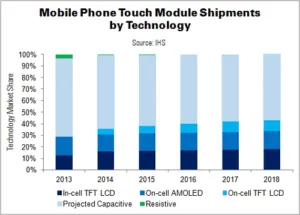Almost 40% of touch module shipments for mobile phones will use in- and on-cell touch this year, says IHS. The prediction comes following 47% YoY growth for the technologies last year, when they had a 36% market share.
Together, Apple and Samsung had a 40% share of the 2014 global smartphone market. Their growing use of in- and on-cell touch is driving the direction of the overall touch sensor market. Japan Display (JDI) also uses hybrid in-cell touch in some displays for tier-one brands including LG, Xiaomi and Huawei.
According to IHS, in-cell touch displays performed very well thanks to the success of Apple’s iPhone 6. JDI’s decision to approach ‘name’ brands with its Pixel Eyes module helped the company to achieve 51% YoY shipment growth last year.
On-cell TFT-LCD touch successfully entered the entry-level and mid-range markets last year, growing from sub-5 million units in 2013 to over 67 million in 2014. On-cell AMOLED only grew 9% YoY, due to Samsung’s slowing smartphone growth.
Embedded touch solutions have extended into all smartphone segments since last year. Apple and JDI’s in-cell displays and Samsung’s on-cell, primarily focus on the high-end market. The entry-level and mid-range are covered by on-cell TFT-LCD using single-layer patterning.
Calvin Hsieh of IHS said, “Due to fierce market competition, declining average selling prices and panel oversupply, panel makers hope embedded touch displays will sway their name-brand customers with the technology’s advantages, such as simplified structure, thickness and competitive costs… Customer preference for embedded touch displays can increase selling prices and revenues; consequently, nearly all panel makers are aggressively approaching smartphone brands with their own solutions”.
Embedded touch displays are increasingly taking share from add-on touch, as technology and yields mature. “Module makers will need to develop new applications to survive”, said Hsieh.

